engine AUDI S6 2015 Workshop Manual
[x] Cancel search | Manufacturer: AUDI, Model Year: 2015, Model line: S6, Model: AUDI S6 2015Pages: 314, PDF Size: 77.57 MB
Page 198 of 314
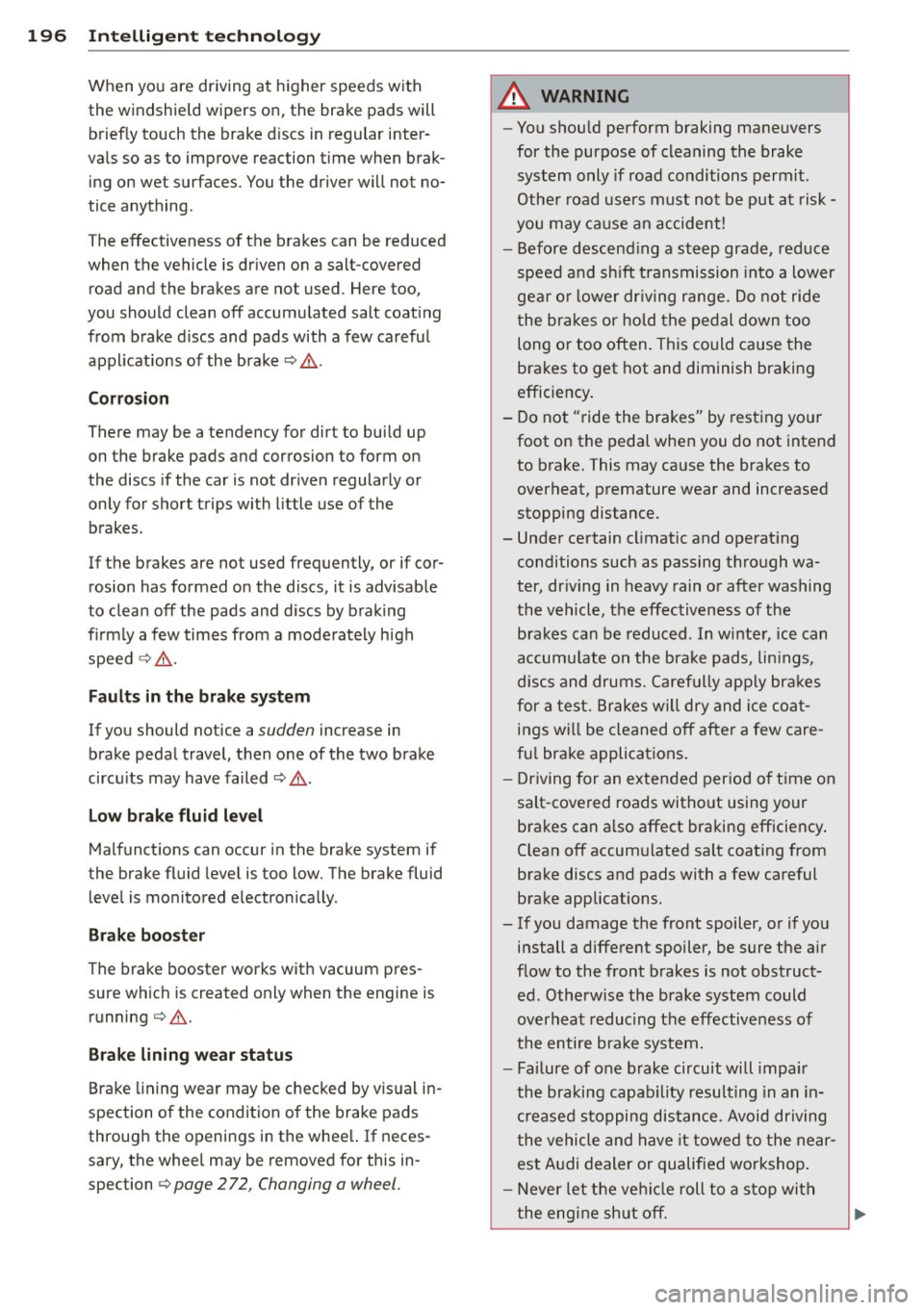
196 Intellig ent technolog y
When you are driving at higher speeds with
the windshield wipers on, the brake pads will
briefly touch the brake d iscs in regular inter
vals so as to improve reaction t ime when brak
ing on wet surfaces. You the driver will not no
tice anything .
The effectiveness of the brakes can be reduced
when the vehicle is dr iven on a salt-covered
road and the brakes are not used. Here too,
you should clean
off accumulated salt coat ing
from brake d iscs and pads with a few careful
applications of the brake¢.&. .
Cor ro sion
There may be a tendency for dirt to build up
on the brake pads and corrosion to form on
the discs if the car is not dr iven regularly or
only for short trips with l ittle use of the
brakes .
If the brakes are not used frequently, or if cor rosion has formed on the discs, it is advisable
to clean
off the pads and discs by braking
firm ly a few times from a mode rately high
speed ¢.& .
Faults in the brake system
If you should notice a sudden increase in
brake pedal travel, then one of the two brake
circu its may have failed¢.&. .
Low brake fluid le vel
Malfunct ions can occur in the brake system if
the brake fluid level is too low. The brake fluid
level is monitored electronically .
Brake boost er
The brake booster works with vacuum pres
sure which is created only when the engine is
running ¢ .&. .
Brake lining w ear status
Brake lining wea r may be checked by vis ual in
spection of the condition of the brake pads
through the openings in the whee l. If neces
sary, the whee l may be removed for this in
spection
¢ page 272, Changing a wheel.
_& WARNING
- You shou ld perform braking maneuvers
for the purpose of cleaning the brake
system only if road conditions permit .
Other road users must not be put at risk -
you may ca use an accident!
- Before descend ing a steep grade, reduce
speed and sh ift transmission into a lower
gear o r lower dr iving range. Do not ride
the br akes or ho ld the pedal down too
long o r too often . Th is could cause the
brakes to get hot and diminish braking
efficiency .
- Do not "ride the brakes" by resting your foot on the pedal when you do not intend
to brake. This may cause the brakes to
overheat, premature wear and increased
stopping distance.
- Under certain climatic and ope rat ing
conditions such as passing through wa
ter , dr iving in heavy rain or after washing
the vehicle, the effectiveness of the b rakes can be reduced . In winte r, ice can
accumu late on the bra ke pads, lin ings,
d iscs and drum s. Carefully app ly bra kes
for a test. Brakes will dry and ice coa t
ings wi ll be cleaned
off after a few care
fu l brake applicat ions.
- Driving for an extended period of t ime on
salt -covered roads without using your
brakes can a lso affect braking efficiency .
Clean
off accum ulated salt coating from
brake discs and pads with a few careful
brake applications.
- If you damage the front spoiler, or if you
install a different spoiler, be sure the a ir
f low to the front brakes is not obstruct
ed. Otherwise the brake system could
overheat reducing the effective ness of
the entire brake system.
- Failure of one brake circuit will impa ir
the braking capab ility result ing in an in
creased stopping distance . Avoid driving
the vehicle and have it to wed to the near
est A udi dealer or qualif ied workshop .
- Never let the vehi cle roll to a s top with
the eng ine shut
off.
Page 199 of 314
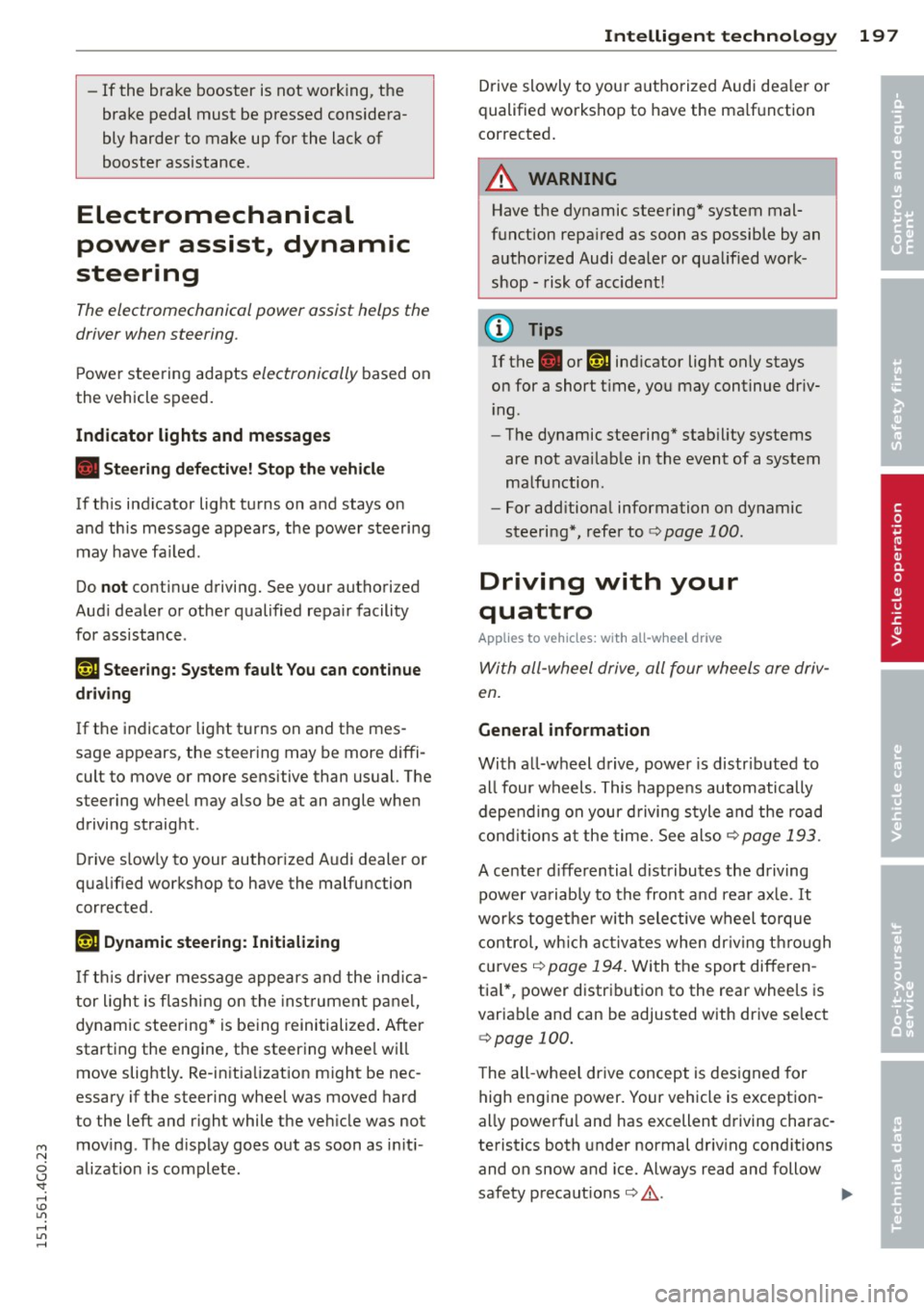
-If the brake booster is not working, the
brake pedal must be pressed considera
bly harder to make up for the lack of
booster assistance.
Electromechanical
power assist, dynamic
steering
The electromechanical power assist helps the
driver when steering .
Power steering adapts electronically based on
the vehicle speed.
Indicator lights and messages
• Steering defective! Stop the vehicle
If this indicator light turns on and stays on
and this message appears, the power steering
may have failed.
Do
not continue driving. See your authorized
Audi dealer or other qualified repair facility
for assistance .
'y. ij Steering: System fault You can continue
driving
If the indicator light turns on and the mes
sage appears, the steering may be more diffi
cult to move or more sensitive than usual. The
steering wheel may also be at an angle when
driving straight .
Drive slow ly to your authorized Audi dealer or
qualified workshop to have the malfunction
corrected.
' :r- ij Dynamic steering: Initializing
If this d river message appears and the indica
tor light is flashing on the instrument panel,
dynamic steering* is being reinitialized. After
starting the engine, the steering whee l w ill
move slightly. Re-initialization might be nec
essary if the steering wheel was moved hard
to the left and right while the vehicle was not
ev1 moving . The display goes out as soon as initi-
"' 8 alization is complete .
'SI: ,...., \!) 1.1"1 ,...., 1.1"1 ,....,
Intelligent technology 197
Drive slowly to your authorized Audi dea ler or
qualified workshop to have the ma lfunction
corrected.
_& WARNING
Have the dynamic steering* system mal
function repa ired as soon as possible by an
authorized Audi dealer or qualified work
shop -risk of acc ident!
(D Tips
If the . or (;r, ij ind icator light only stays
on for a short time, you may continue driv ing .
- The dynamic steering* stability systems
are not available in the event of a system
malfunction.
- For additional information on dynamic
steering*, refer to¢
page 100.
Driving with your
quattro
Applies to veh icles: w it h all -w hee l drive
-
With all-wheel drive, all four wheels are driv
en.
General information
With all-wheel drive, power is distr ibuted to
all four wheels. This happens automatically
depending on your driving style and the road
cond it ions at the time. See also
Qpage 193.
A center differential distributes the driving
power variably to the front and rear axle.
It
works together with selective wheel torque
control, wh ich activates when driving through
curves ¢
page 194. With the sport differen
tia l*, power distribution to the rear wheels is
variable and can be adjusted with drive se lect
¢ page 100.
The all-whee l drive concept is des igned for
high engine power. Your vehicle is exception
ally powerful and has excellent driving charac
teristics both under normal driving conditions
and on snow and ice. Always read and follow
safety precautions ¢
&- .,._
•
•
Page 200 of 314
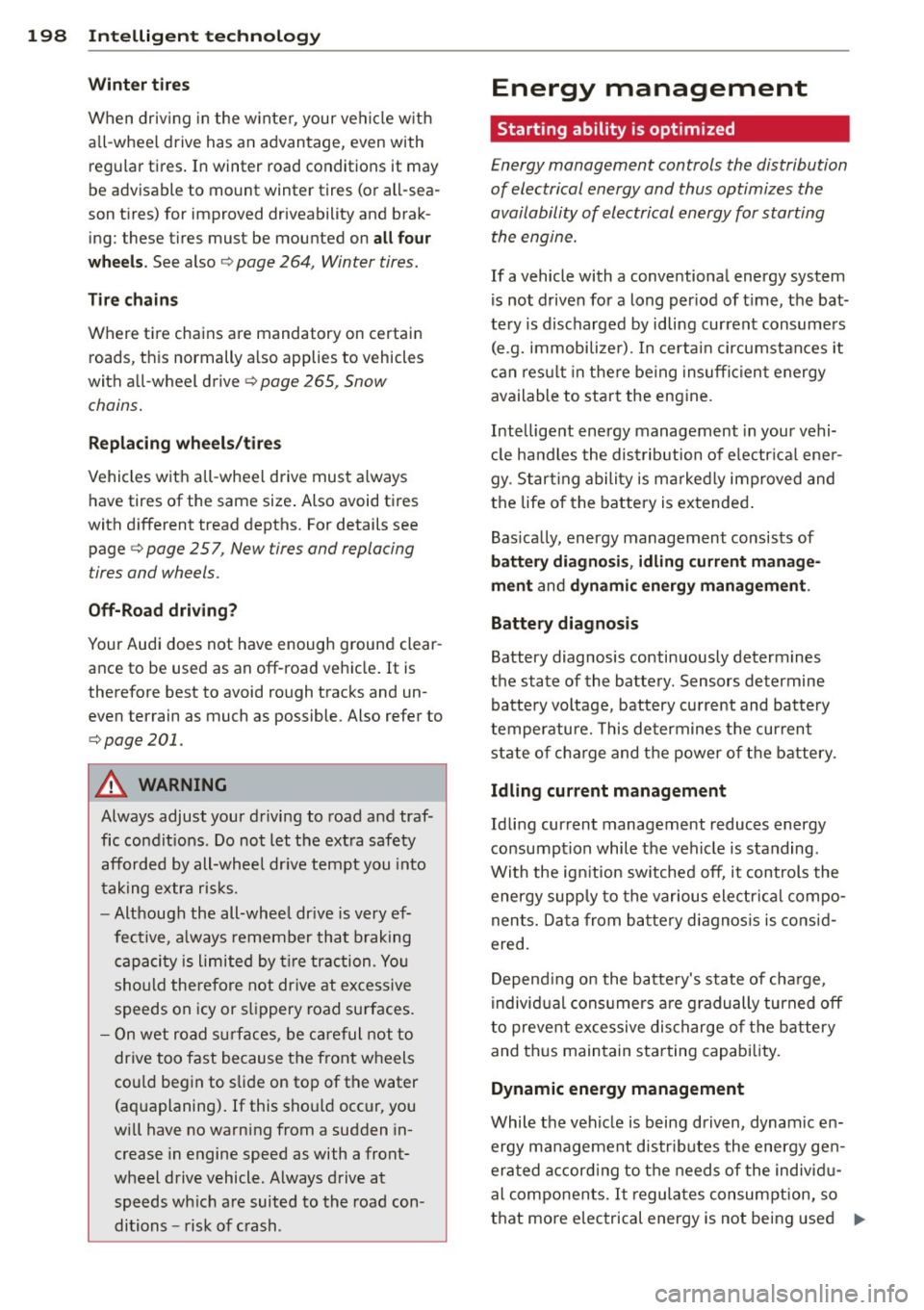
198 Intelligent technology
Winter tires
When dr iv ing in the w inter, your ve hicl e w ith
a ll-whee l drive has an advantage,
even with
regular ti res . In winter road conditions it may
be advisable to mount winter tires (o r all-sea
son t ires) for improved driveability and brak
ing: these tires must be mounted on
all four
whe els .
See also c:> page 264, Winter tires.
Tire chains
Where tire cha ins are mandatory on certa in
roads, th is normally a lso applies to vehicles
with a ll-wheel drive
c:> page 265, Snow
chains.
Replacing wheel s/tir es
Vehicles w ith all-wheel drive must a lways
have tires of the same size . Also avoid tires
with d ifferent tread depths. For details see
page
c:> page 257, New tires and replacing
tires and wheels.
Off-Road driv ing?
Your Audi does not have enough ground clear
ance to be used as an off-road ve hicle . It is
therefore best to avoid rough tracks and un
even terrain as much as possible. Also refer to
c:> page 201.
A WARNING
Always adjust your driving to road and traf
fic conditions . Do not let the ext ra safety
afforded by all-wheel dr ive tempt you into
taking extra risks.
- Alt hough the all-whee l dr ive is
very ef
fec tive, a lways remember that b raking
c ap aci ty is limited by tire traction. Yo u
sho uld the re fo re not dr ive at excessive
speeds on icy or slippery road su rfaces.
- O n wet road s urfa ces, be c areful not to
drive too fast because the front wheels
cou ld begin to sli de on top of the water
(aq uaplaning) . If this sho uld occ ur, you
will have no warn ing from a sudden in
crease in engine speed as with a front
w heel d rive vehicle. A lways drive at
speeds w hich are suited to the road con
ditions -risk of c rash.
Energy management
Starting ability is optimized
Energy management controls the distribution
of electrical energy and thus optimizes the
availability of electrical energy for starting the engine.
If a vehicle with a conventiona l energy system
is not driven for a long period of t ime, t he bat
te ry is discharged by idling current consume rs
(e .g. immobili ze r). In certa in circumstan ces it
ca n res ult in the re be ing insu ffic ien t energy
available to start the eng ine.
Intelligent energy management in your vehi
cl e ha ndles the dist rib ution o f electr ica l ene r
gy. Start ing abili ty is m arke dly improved and
the life of the battery is extended .
Bas ica lly, energy management consists of
battery diagnosis , idling current manage
ment
and dynamic energy management .
Battery diagnosis
Battery diagnosis continuously determines
the state of the batte ry. Sensors determine
batte ry voltage, batt ery cu rr e nt and battery
tempe ratu re. This de termines the cur ren t
sta te o f cha rge and t he power o f th e battery.
Idling current management
Idli ng cur rent management reduces energy
consumpt ion while the vehicle is standing .
With the ig nition sw itched off, it controls the
energy supp ly to the variou s ele ctri ca l compo
nen ts. Da ta from ba ttery d iagnos is is co nsid
ered.
Depend ing on the batte ry's state of cha rge,
i ndivid ual con sume rs are g radually turned off
to prevent excessive discharge o f the battery
and th us main tain starting capabi lity.
Dynamic energy management
While the vehicle is being d riven, dynamic en
ergy ma nagement distr ib utes the energy ge n
era ted a ccord ing to t he needs of the indivi du-
al components .
It regula tes consumption, so
t h at more electrical energy is not being used ..,.
Page 201 of 314
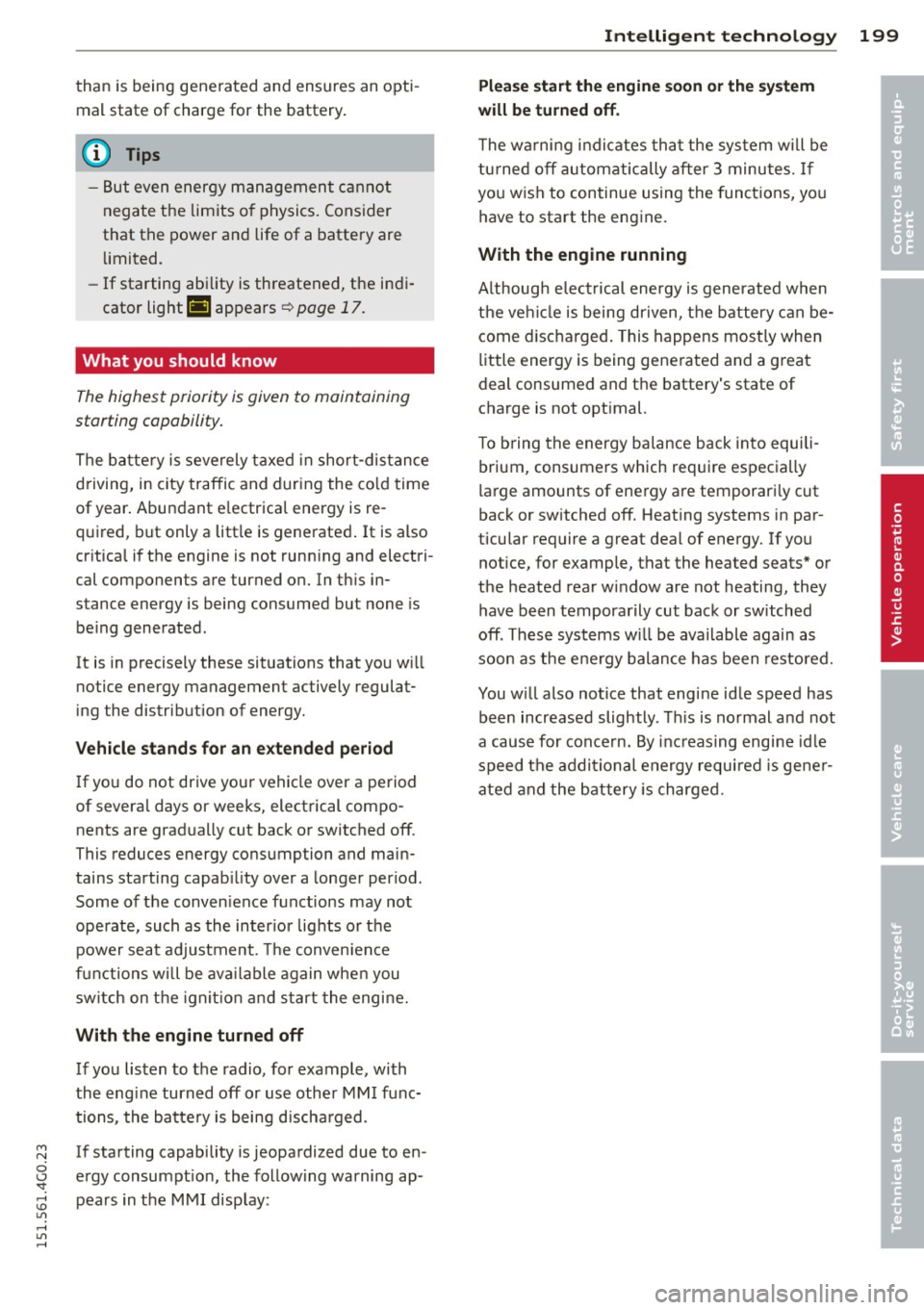
M N
0 <.J 'SI: ,...., \!) 1.1'1 ,...., 1.1'1 ,....,
than is being generated and ensures an optimal state of charge for the battery.
@ Tips
- But even energy management cannot
negate the limits o f physics. Consider
that the power and life of a battery are
limited.
- If starting ab ility is threatened, the indi
cator light (•) appears
¢ page 17.
What you should know
The highest priority is given to maintaining
starting capability.
The battery is severely taxed in short-dis tance
driving, in city traffic and d uring the co ld time
of year . Abu ndant e lectrica l energy is re
q uired, but only a litt le is generated . It is also
cr itical if the engine is not runn ing and electri
cal components are turned on. In th is in
stance energy is being consumed but none is
be ing generated.
It is in precisely these situations that you w ill
notice energy management actively regulat
i n g the distribution of energy.
Vehicle stand s for an e xte nded period
If yo u do not drive you r vehicle over a period
of severa l days or weeks, electrical compo
nents are grad ually cut back or switched off.
This reduces energy consumption and main tains starting capab ility over a longer per iod.
Some of the conven ience functions may not
operate, such as the inter ior lights o r the
power seat adjustment. The conven ience
f u nctions will be ava ilable again whe n you
switch on the igni tion and start the engine.
With the engine turned off
If you lis ten to t he radio, for example, with
the eng ine turned off or use othe r MM I fu nc
tions, the bat te ry is being discha rged .
If starting capability is jeopardized due to en
e rgy consumpt ion, the follow ing warning ap
pears in the MMI disp lay :
Int ellig ent technolog y 199
Plea se start the engine soon or the sy stem
will be turned off .
The wa rni ng ind ic ates th at the sys tem w ill be
t u rned o ff autom atically a fter 3 minu tes. If
you w ish to continue using the funct ions, yo u
have to start the engine.
With the engine running
Althoug h elec trical energy is generated when
t h e ve hicl e is being driven, t he battery can be
come d isc harged. This happe ns mostly when
little energy is being generated and a g reat
deal consumed and the battery's state of
charge is not opt imal.
T o b ring the energy ba lance back in to equili
brium, consumers which req uir e especially
l a rge amounts of energy a re temporari ly cut
back or sw itched off. Heat ing systems in par
ticular require a great deal of energy. If you notice, for example, that the heated seats* or
the heated rear window are not heating, they
have been temporarily cut back or switched
off . These systems w ill be availabl e again as
soon as the ene rgy balance has been restored.
You w ill also notice that engine id le speed has
been increased slightly . Thi s is no rmal and not
a cause for concern. By inc reas ing engi ne id le
speed the additional e nergy requi red is gene r
ated and the b attery is charged.
•
•
Page 202 of 314
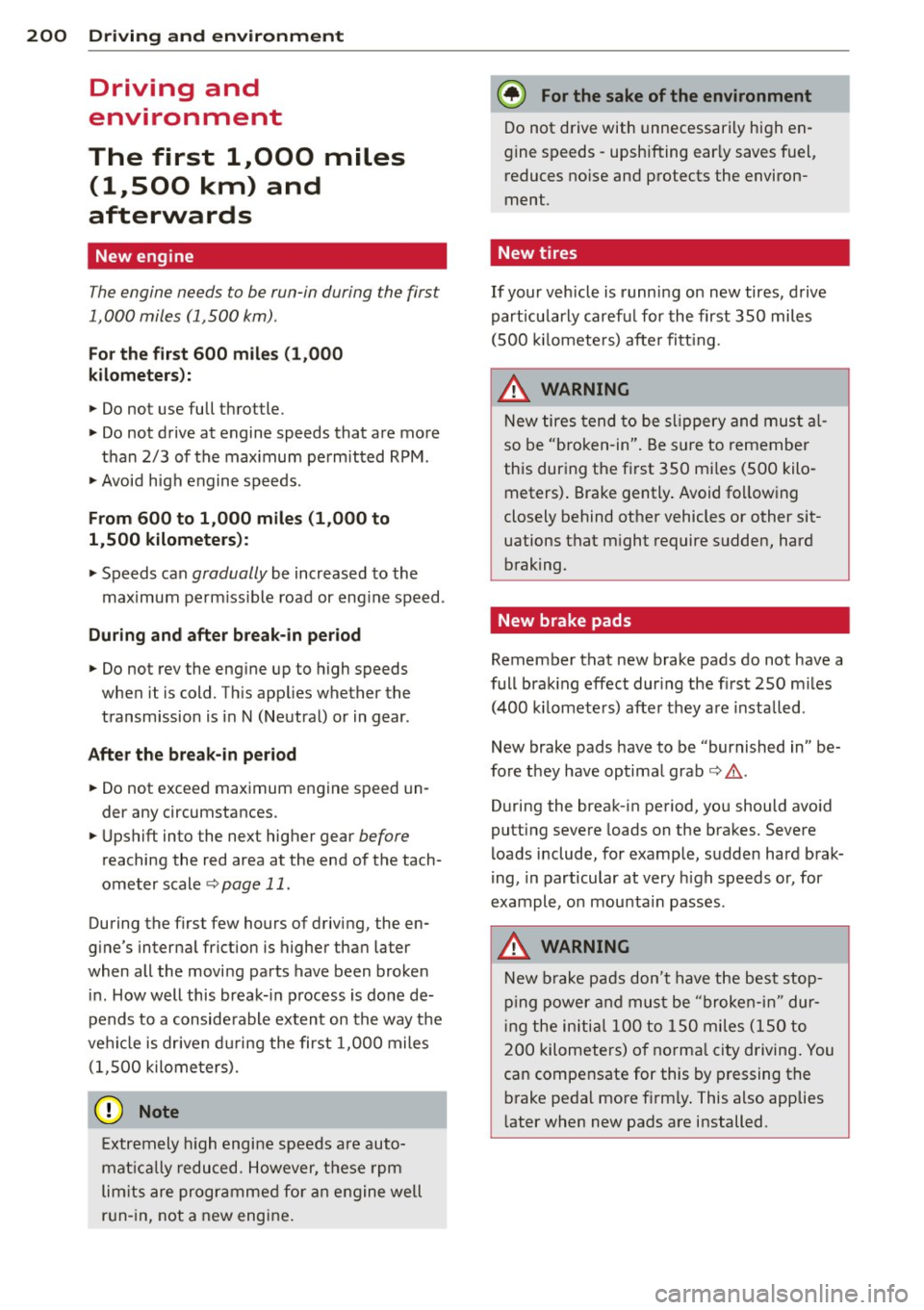
200 Driving and environment
Driving and
environment
The first 1,000 miles
(1,500 km) and
afterwards
New engine
The engine needs to be run-in during the first
1,000 miles (1,500 km).
For the fir st 600 miles (1,000
kilometers ):
.,. Do not use full throttle.
... Do not d rive at engine speeds that are more
than 2/3 of the max imum permitted RPM.
... Avoid high engine speeds.
From 600 to 1,000 mile s (1 ,000 to
1,500 kilometers):
... Speeds can gradually be increased to the
max imum pe rm iss ible road or eng ine speed .
During and after break-in period
.,. Do not rev the eng ine up to high speeds
when it is cold. Th is app lies whether the
transm ission is in N (Neutra l) or in gear.
After the break-in period
... Do not exceed maximum engine speed un
der any circumstances.
.,. Upshift into the next hig her gear
before
reaching the red area at the end of the tach
ometer scale
c:> page 11.
During the first few hours of driving, the en
g ine's interna l friction is higher than later
when all the moving parts have been broken
in . How well this break- in process is do ne de
pends to a conside rable extent on th e way the
ve hicl e is driven during the first 1,0 00 miles
(1, 500 k ilome ters).
0 Note
E xtremely high engi ne speeds are auto
mat ica lly reduced. However, these rpm
lim its are progr amme d for an engine well
r u n- in, not a new engine .
{® For the sake of the environment
Do not drive with unnecessarily high en
g ine speeds - upshifting ear ly saves fuel,
reduces no ise and protects the environ
ment.
, New tires
If your vehicle is runni ng on new tires, drive
part icularly caref ul for the first 350 miles
(500 kilomete rs) afte r fitt ing.
A WARNING
N ew tires tend to be sl ippery and mus t al
so be "b roken -in" . Be s ure to remember
this dur ing the fi rst 350 mi les ( 500 kilo
meters) . Brake gently . Avoid fo llow ing
closely behind other vehicles or other sit
uations that m ight require sudden, hard
braking .
New brake pads
Remember that new brake pads do not have a
full bra king effect dur ing the fi rst 250 m iles
(400 kilomete rs) afte r they a re insta lled.
New brake pads have to be "burnished in" be
fo re t hey have optima l grab
c:> A .
During the break- in period, you should avoid
putting severe loads on the brakes. Severe
l oads include, for example, sudden hard brak
i ng, in particular at very high speeds or, for
example, on mounta in passes .
A WARNING
New b rake pa ds don't have t he bes t stop
pi ng power and mus t be "broke n-in " dur
i ng the in iti al 1 00 to 150 mi les (150 to
20 0 k ilometers) of no rma l city driving . You
can compensate for this by pressing the
br ake peda l mo re f irm ly . This also applies
l ater when new pads are installed.
Page 203 of 314
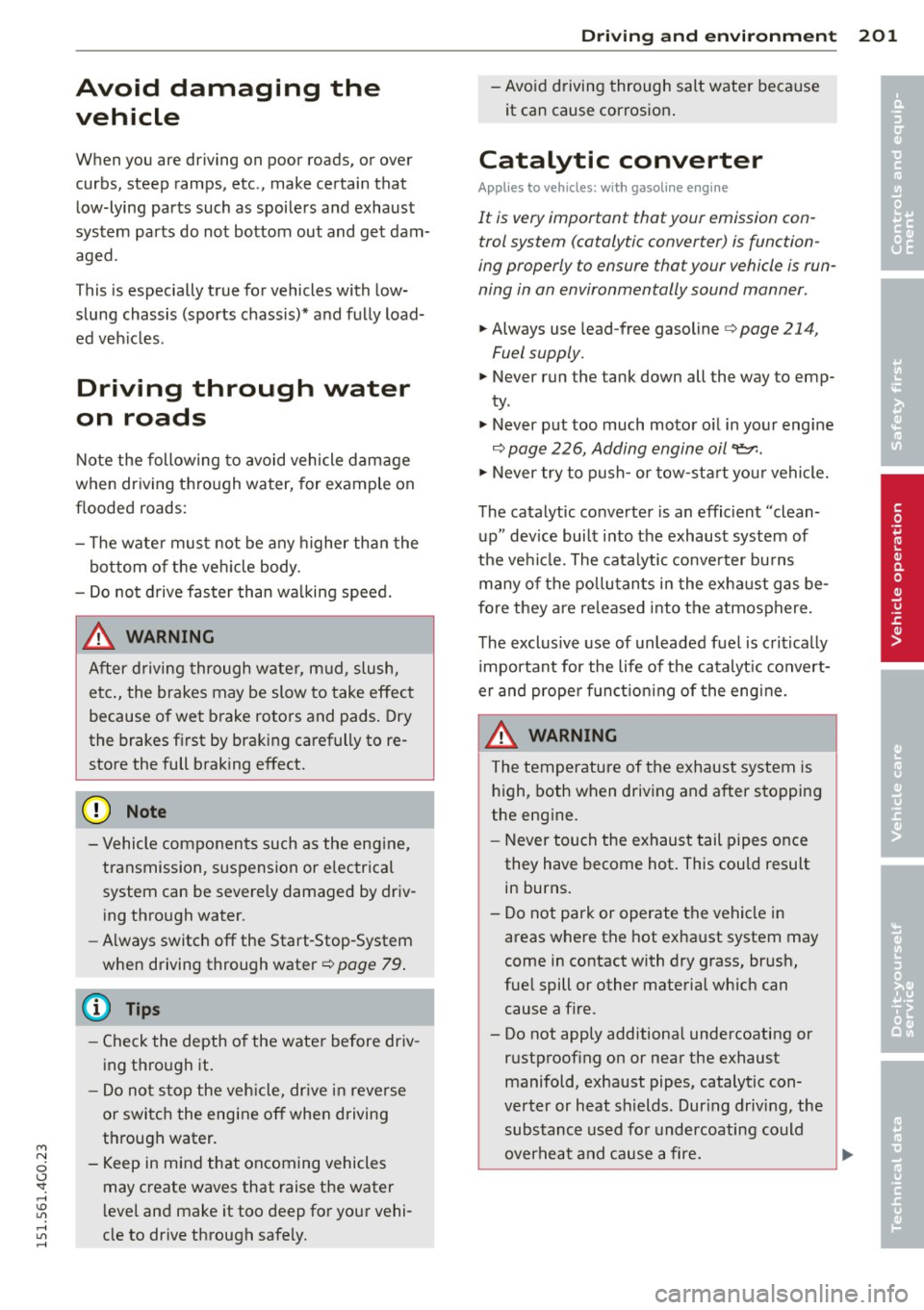
M N
0 <.J 'SI: ,...., \!) ..,.,
,...., ..,., ,....,
Avoid damaging the
vehicle
When you are driving on poor roads, or over
curbs, steep ramps, etc., make certain that
low-lying parts such as spoilers and exhaust
system parts do not bottom out and get dam
aged.
This is especially true for vehicles with low
slung chassis (sports chassis) * and fully load
ed veh icles.
Driving through water
on roads
Note the following to avoid vehicle damage
when driving through water, for example on
flooded roads:
- T he water must not be any h igher than the
bottom of the veh icle body.
- Do not d rive faster than wa lking speed.
..&, WARNING
After driving through wate r, m ud, slush,
etc., the brakes may be slow to take effect
because o f wet brake rotors and pads . Dry
the brakes first by braking carefully to re
store the full braking effect.
(D Note
- Vehicle components such as the eng ine,
transmission, suspension or e lectrical
system can be severely damaged by driv
ing thro ugh water.
- Always switch
off the Start-Stop-System
when driving through water¢
page 79 .
@ Tips
-Check the depth o f the wate r before driv
ing through it.
- Do not s top the veh icle, dr ive i n reverse
or switc h the engine off when driving
through water.
- Keep in mind that oncom ing vehicles
may create waves that raise the water
l eve l and make it too deep for you r vehi
cle to drive through safely .
-
Dri vin g and en vironm ent 201
- Avo id driving through salt wate r because
it can cause corrosion .
Catalytic converter
Applies to vehicles: w ith gasoline engine
It is very important that your emission con
trol system (catalytic converter) is function
ing properly to ensure that your vehicle is run
ning in an environmentally sound manner.
... Always use lead-free gasoline ¢ page 214,
Fuel supply.
... Never run the tank down all the way to emp
ty.
.,. Never put too much motor o il in your engine
¢ page 226, Adding engine oil~-
... Never try to push- or tow-sta rt your vehicle.
The catalytic converter is an efficient "clean
up" dev ice bui lt into the exhaust system of
the ve hicle. The cata lytic conve rter bu rns
many of the pollutants in the exha ust gas be
fore they are re leased into the atmosphere .
The exclusive use of unleaded fuel is c ritically
important for the life of the ca talyt ic convert
er and proper f unct ion ing of the engine.
A WARNING
The temperature of the exhaust system is
high, both when driving and after s topping
the engine.
- Never touch the exhaust tail pipes once
they have become hot . This cou ld result
in burns .
- Do not park or operate the vehicle in
areas where the hot exha ust system may
come in contact with dry grass, brush,
fue l spill or other material which can
cause a fire.
- Do not apply additional undercoating or
rustproof ing on or near the exhaust
manifold, exhaust pipes, catalytic con
verter or heat shields . Dur ing driv ing, the
substance used fo r undercoating could
overheat and cause a fire.
~
•
•
Page 204 of 314
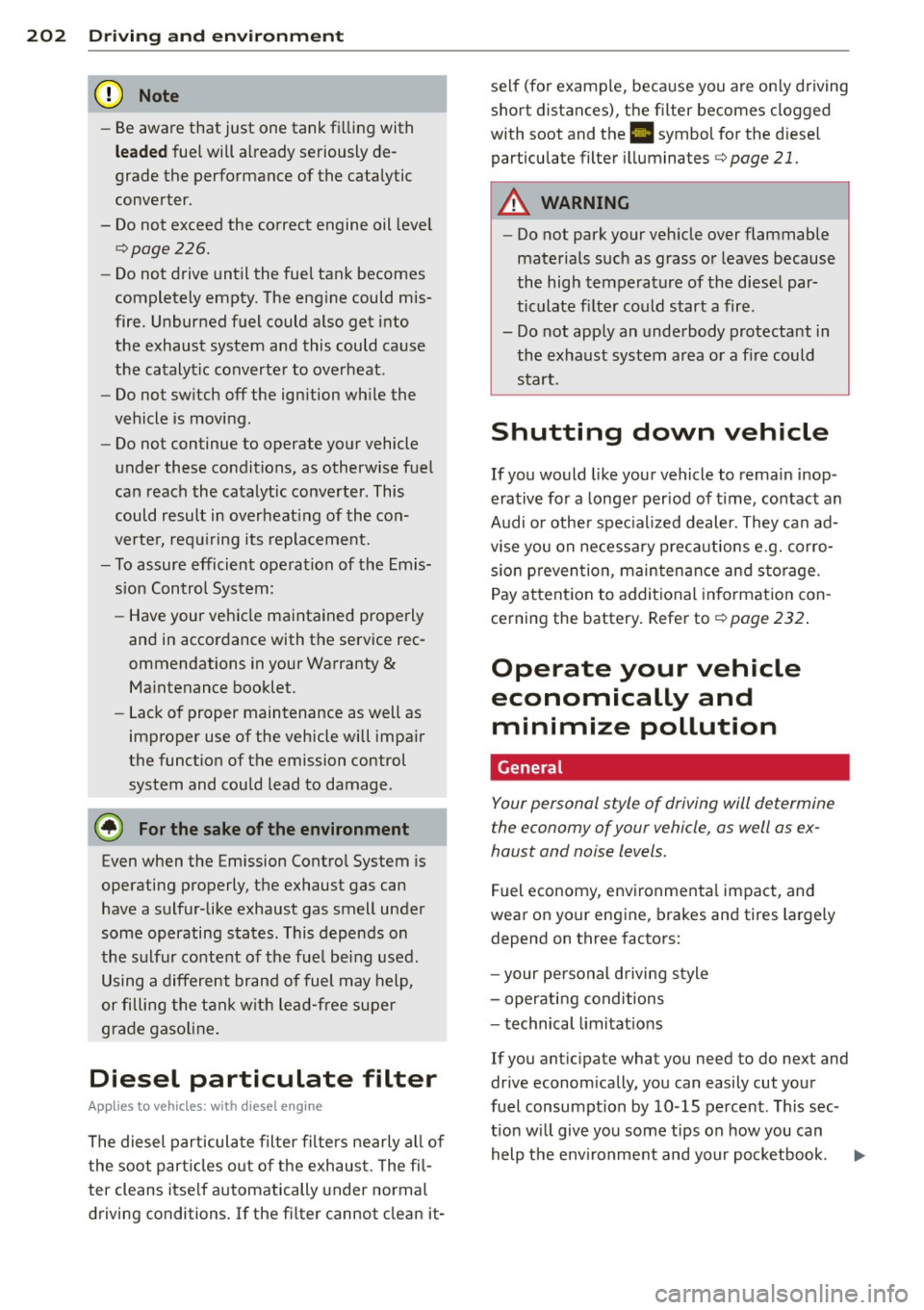
202 Driving and en vir onm ent
- Be aware that just one tank fi lling with
le a ded fuel will already seriously de
grade the performance of the catalytic
converter.
- Do not exceed the correct engine oil leve l
¢page 226.
-Do not drive until the fuel tank becomes
completely empty. The eng ine could mis
fire. Unburned fuel could also get into
the exhaust system and this could cause
t h e catalyt ic converter to overheat.
- Do not switch off the ign ition wh ile the
vehicle is moving.
- Do not continue to operate your vehicle
under these conditions, as otherw ise fuel
can reach the catalytic converter. This
could result in overheat ing of the co n
ve rter, req uiring its repla ceme nt.
- To assure efficient operation of the Emis
s ion Control System:
- Have your vehicle maintained properly
and in accordance with the service rec
ommendations in your Warranty
&
Ma intenance booklet.
- Lack of proper maintenance as well as
improper use of the vehicle will impa ir
the funct ion of the emission control
system and cou ld lead to damage.
@) For the sake of the environment
Even when the Emission Contro l System is
operating properly, the exhaust gas can
have a sulfur-like exhaust gas smell under
some operating states. This depends on
t he s ulfur content of the fue l being used .
Using a differe nt brand of fuel may help,
or filling the tank w it h lead-free super
grade gaso line .
Diesel particulate filter
Appl ies to vehicles: with diesel e ngin e
The diesel particula te filter fi lters nearly a ll of
the soot part icles o ut o f the exhaus t. T he fi l
ter cleans itse lf automatically under normal
driving conditions . If the fi lter cannot clean it- se
lf (for example, because you are on ly driving
short distances), the f ilter becomes clogged
with soot and the
II symbol for the diese l
part icu late filter illuminates
¢page 21.
A WARNING
-Do not park your veh icle over flammable
materials such as grass or leaves because
the high temperature of the diesel par
ticulate fi lt e r could start a fire.
- Do not app ly an underbody protectant in
the ex haust system area o r a f ire could
start.
Shutting down vehicle
If you would like your vehicle to remain inop
erative for a longe r per iod of t ime, contact an
A udi o r othe r spec ia liz ed dealer. They can ad
v ise you on necessa ry precautions e.g. corro
s io n preven tion, mainten ance and s torage.
Pay a ttent ion to addi tional in format ion con
cerning the battery. Refer to¢
page 232 .
Operate your vehicle
economically and
minimize pollution
General
Your personal style of driving will determine
the economy of your vehicle, as well as ex
haust and noise levels.
F uel economy, envi ronmenta l impact, and
wear on your engine, b rakes and tires largely
depend on three factors:
- your pe rsonal d riving s tyle
- operati ng conditions
- technical limitat ions
If you ant ic ipate what you need to do next and
drive economically, you can easily cut your
fuel consumpt io n by 10-15 percent . This sec
t ion w ill give you some tips on how you can
help t he env ironme nt and your pocketbook. ..,.
Page 205 of 314
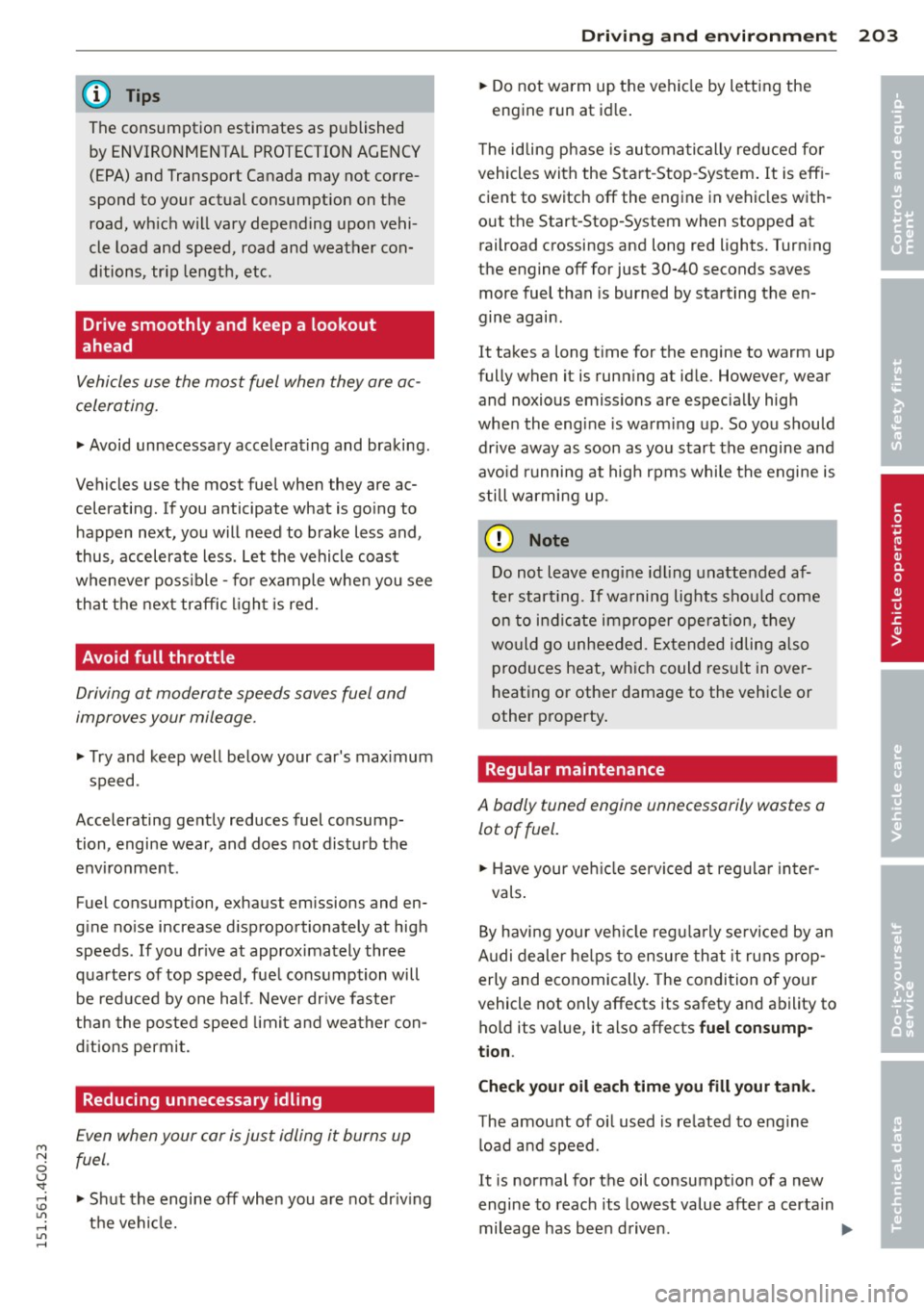
M N
0 <.J 'SI: ,...., \!) 1.1'1 ,...., 1.1'1 ,....,
@ Tips
The consumption estimates as published by ENVIRONMENTAL PROTECTION AGENCY (EPA) and Transport Canada may not corre
spond to your actual consumption on the
road, wh ich will vary depend ing upon vehi
cle load and speed, road and weather con
ditions, tr ip length, etc.
Drive smoothly and keep a lookout
ahead
Vehicles use the most fuel when they are ac
celerating.
~ Avoid unnecessary accelerating and braking.
Vehicles use the most fuel when they are ac
celerating . If you anticipate what is go ing to
h appen next, you will need to brake less and,
thus , accelerate less . Let the vehicle coast
wheneve r poss ible -fo r example when you see
that the nex t traffic light is red.
Avoid full throttle
Driving at moderate speeds saves fuel and
improves your mileage.
~ T ry and keep well below your car's max imum
speed.
Accelerating gent ly reduces fuel consump
tion, engine wear, and does not disturb the
environment .
Fuel consumption, exhaust emissions and en
g ine no ise increase d ispropo rtionately at high
speeds . If you dr ive at approximately three
quarters of top speed, fue l consumption will
be red uced by one ha lf. Never dr ive faste r
than the posted speed limit and wea ther con
d itions permit.
Reducing unnecessary idling
E ven when your car is just idling it burns up
fuel .
~ Shut the engine off when you are not dr iv ing
the vehi cle.
Dri vin g and en vironm ent 203
~ Do not warm up the vehicle by lett ing the
engine run at id le .
T he id ling phase is au toma tic ally red uced for
vehicles with the Start -Stop -System . It is eff i
cient to switch off the engine in vehicles with
out the Start-Stop-System when stopp ed at
railroad crossings and long red lights. Turning
the engine off for jus t 30-40 seconds saves
more fuel than is burned by start ing the en-
. . gme again .
It takes a long t ime for the engine to warm up
fully when it is run ning at id le. However, wear
and noxious emissions are especia lly high
when the engine is warm ing up . So you should
dr ive away as soon as you start the engine and
avo id running at high rpms whi le the engine is
sti ll warming up.
(L} Note
Do not leave eng ine idling unattended af
ter start ing .
If wa rni ng lights sho uld come
on to indicate improper ope ration, t hey
wo uld go unheeded . Extended idlin g also
produces heat, wh ich could res ult in ove r
heating or other damage to the veh icle or
other p roperty .
Regular maintenance
A badly tuned engine unnecessarily wastes a
lot of fuel.
~ Have your ve hicle servi ced at reg ular i nter-
vals .
By havi ng your ve hicle regu la rly se rviced by an
Audi dealer he lps to ensu re tha t it ru ns prop
erly and economically . The condition of your
vehicle not on ly affects its safety and ability to
ho ld its va lue, it a lso affects
fuel consump
tion .
Check your oil e ach time you fill your tank.
T he amou nt of oi l used is re lated to engine
load and speed.
It is normal for the oil consumption of a new
engine to reac h its lowest value after a certa in
mileage has been d riven . .,..
•
•
Page 206 of 314
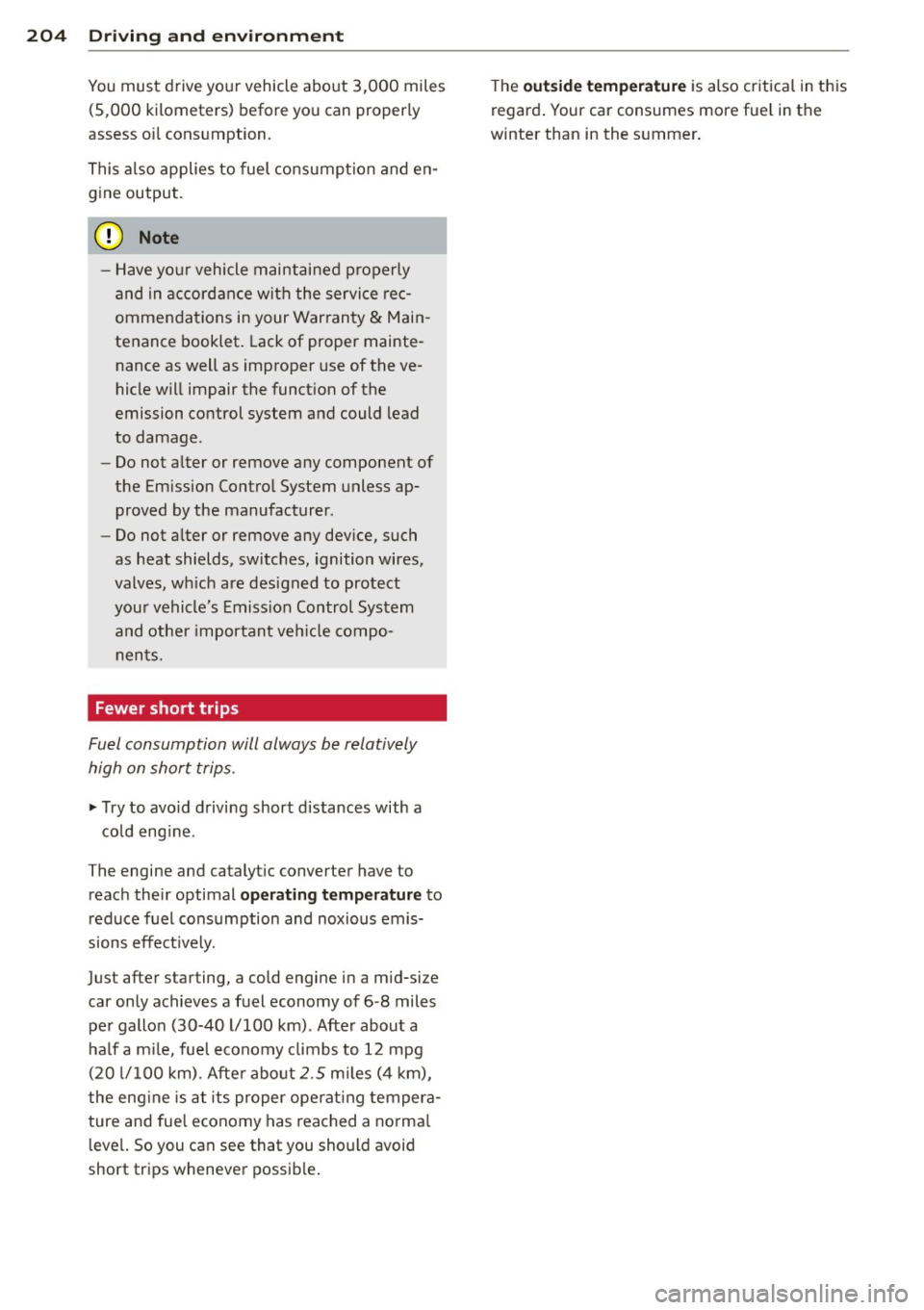
204 Driving and en vir onm ent
You must drive your vehicle about 3,000 miles
(5,000 kilometers) before you can properly
assess o il consumption.
This a lso applies to fuel consumption and en
gine output.
0 Note
- Have yo ur vehicle maintained properly
and in accordance with the service rec
ommendations in your Warranty
& Main
tenance booklet. Lack of proper mainte
nance as well as improper use of the ve
hicle will impair the funct ion of the
emission control system and could lead
to damage .
- Do not alter or remove any component of
the Emi ssion Control System unless ap
proved by the manufacturer .
- Do not alter or remove any dev ice, such
as heat shields, switches, ignition wires,
valves, wh ich are designed to protect
your vehicle's Emiss ion Control System
and othe r important veh icle compo
nen ts.
Fewer short trips
Fuel consumption will always be relatively
high on short trips .
.. Try to avo id driving short d istances with a
co ld eng ine .
The engine and ca talytic conver ter have to
reach their optimal
op erating temp eratur e to
reduce fuel consumption and noxious emis
sions effect ively.
Jus t after s tarting, a cold engine in a mid-size
car only achieves a fuel economy of 6 -8 miles
per gallon (30-40 l/100 km) . After about a
ha lf a m ile, fue l economy climbs to 12 mpg
(20 l/100 km). Afte r abo ut
2 .5 m iles (4 km),
the eng ine is at its proper ope rat ing tempera
ture and fue l economy has reached a norma l
l eve l. So you can see that you should avoid
short trips whenever possib le . T
he
ou tsid e tempe rature is also critical in this
regard . Your car consumes more fue l in the
winter than in the summer.
Page 207 of 314
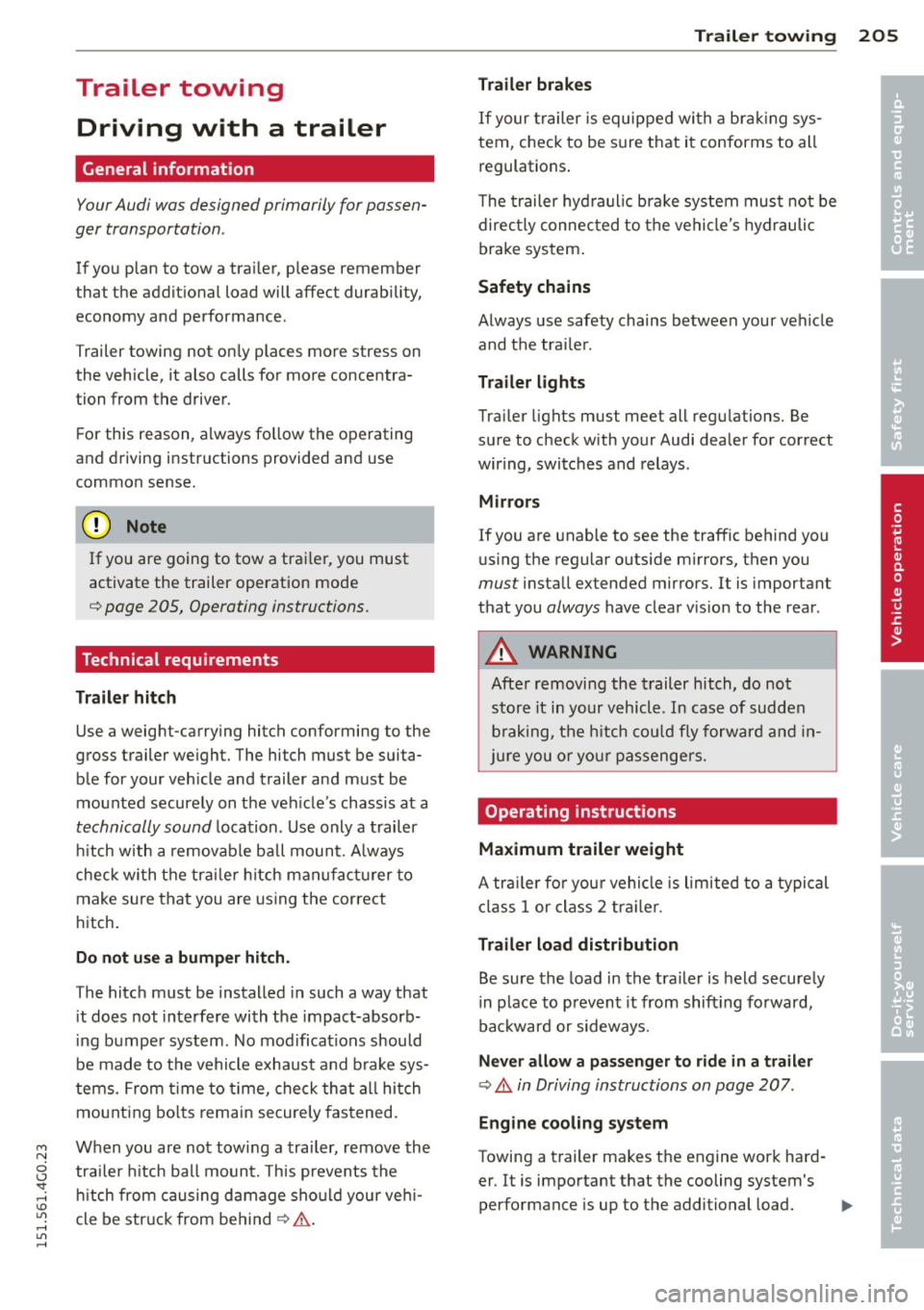
M N
0 <.J 'SI: ,...., \!) ..,.,
,...., ..,., ,....,
Trailer towing Driving with a trailer
General information
Your Audi was designed primarily for passen
ger transportation .
If you plan to tow a tra iler, p lease remember
that the addit ional load will affect durab ility,
economy and performance .
Trailer towing not on ly places more stress on
the vehicle, it also calls for more concentra
tion from the driver.
F or this reason, a lways fo llow the operating
and driving instructions provided and use
common sense.
(D Note
If you are going to tow a trai le r, you must
ac tivate the trailer operation mode
c::> page 205, Operating instructions.
Technical requirements
Trailer hitch
Use a weig ht-carrying hitch conforming to the
gross trailer we ight. The hitch must be suita
b le for your veh icle and trailer and must be
mounted secure ly on t he ve hicle's chassis at a
technically sound location . Use only a trail er
hi tch w ith a removab le ball moun t. A lways
check wi th t he tra ile r hi tch man ufactur er to
make sure that you are using the cor rect
h itch.
Do not us e a bumper hitch.
The hitc h m ust be installed in such a way that
i t does not interfe re with the impac t-absorb
i ng bumper syst em. No mod ificat ions should
b e made to the vehi cle e xhaus t and br ake sys
tems . From t ime to time, check th at a ll hitc h
mo unt ing bo lts rem ain securely fas tened.
When you are not towing a trail er, remove the
tra ile r hi tch ball moun t. T h is prevents the
hi tch from causing damage sho uld your ve hi
cle be str uck from behind~ .& .
Trailer towin g 205
Trailer brakes
If your trailer is equippe d wi th a bra king sys
tem, check to be s ure that i t conforms to all
regulations .
T he trailer hyd ra u lic bra ke sys tem mus t not be
d irec tly connec ted to the vehicle's hydraulic
brake system .
Safety chains
Always use safety chains be tween your ve hicle
and t he tra ile r.
Trailer lights
Trai ler lights must meet all reg ulations. Be
su re to c heck with your Audi dea ler for correct
wir ing, switches and relays .
Mirrors
If you a re unable to see the traffic behind you
u sing the regula r outside mirrors, then you
must insta ll extended mir rors. It is important
t h at you
always have clea r vis io n to the rear.
_&. WARNING
-
Afte r removi ng the t railer hitch , do no t
stor e it in yo ur v ehicl e. In case of sudden
b raki ng, the hi tch co ul d fly forwar d and in
j ur e you o r yo ur pass enge rs.
Operating instructions
Maximum trailer weight
A tra ile r fo r you r vehi cle is l imited to a typi cal
cla ss 1 o r class 2 tr ailer.
Trailer load distribution
Be sure the load in the tra ile r is held secure ly
in place to p revent it from shift ing fo rward,
ba ckward or sideways.
Never allow a passenger to ride in a trailer
c::> .& in Driving instructions on page 207 .
Eng ine cooling sy stem
Towing a t railer ma kes the engine wor k hard
er . It is impo rtant that the cooling system's
performance is up to the additional load.
•
•